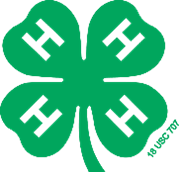1.1 The Indiana 4-H Program Philosophy and Expectations
The Indiana 4-H Youth Development program serves the youth of Indiana by providing a strong educational youth development program. This program delivers educational experiences in a variety of settings. Caring, capable and contributing adults assist in the 4-H program as role models for youth. The rich heritage of the 4-H Program is one to be valued and passed along to future generations.
The Indiana 4-H Youth Policies and Procedures includes certain standards and guidelines to assure that 4-H is a positive youth development program. Legal authority for the 4-H Program rests with the Director of the Cooperative Extension Service at Purdue University. No county 4-H policy may conflict with state 4-H policy or with federal guidelines and requirements. County 4-H policy is guided by the county 4-H policy making or governing board (i.e., 4-H Council) as provided by the Indiana 4-H Youth Development program.
It is the policy of 4-H to be an inclusive organization. No county policy or practice should be used to arbitrarily exclude youth from either membership or participation. Youth should participate in 4-H Youth Development opportunities at levels and times that best suit the youth's development.
Volunteers and Extension Educators may not require youth to attend 4-H club meetings in order to complete 4-H or exhibit their work unless a safety meeting required at the state level is required for the project.
1.2 4-H Mission and Vision Statements
4-H Mission: The Indiana 4-H Youth Development mission is to provide real-life educational opportunities that develop young people who positively impact their community and world.
4-H Vision: Indiana 4-H Youth Development strives to be the premier, community-based program empowering young people to reach their full potential.
1.3 Positive Youth Development
What is Positive Youth Development?
Positive youth development occurs from an intentional process that promotes positive outcomes for young people by providing opportunities, relationships, and the support to fully participate. Youth development takes place in families, peer groups, schools, neighborhoods, and communities.
The Interagency Working Group on Youth Programs, a collaboration of 21 federal departments and agencies that support youth, created the following definition of positive youth development (PYD):
“PYD is an intentional, pro-social approach that engages youth within their communities, schools, organizations, peer groups, and families in a manner that is productive and constructive; recognizes, utilizes, and enhances young people’s strengths; and promotes positive outcomes for young people by providing opportunities, fostering positive youth relationships, and furnishing the support needed to build on their leadership strengths.”
1.4 4-H Pledge
The pledge tells what 4-H is about. The 4-H goal is the four-fold development of youth: Head, Heart, Hands and Health. The pledge was adopted by the delegates of the 1927 National 4-H Club Camp in Washington, D.C. State club leaders voted for and adopted the pledge for universal use. The phrase “and my world” was added in 1973. The saying of the pledge has a prominent place in 4-H activities, at regular 4-H meetings, achievement days and other club events.
I Pledge my Head to clearer thinking,
my Heart to greater loyalty,
my Hands to larger service,
and my Health to better living,
for my club, my community, my country, and my world.
1.5 Motto
The 4-H motto, “To Make the Best Better”, is intended to inspire young people to continue to learn and grow, to make their best efforts better through participating in educational experiences.
1.6 Colors
The 4-H colors are green and white. Green, nature’s most prominent color, symbolizes growth. The white symbolizes purity and high ideals.
1.7 4-H Name and Emblem
The official 4-H Emblem is a clover with four leaves and an “H” on each leaf. The clover’s stem must point to the right as you look at the image. The 4-H Emblem is not a plain four-leaf clover. The 18 USC 707 notice is part of the Emblem.
1.7.1 4-H Name and Emblem Regulations
The 4-H Name and Emblem are protected under federal statute. Congress has delegated to the Secretary of Agriculture responsibility for the proper use of the 4-H Name and Emblem. The Secretary, in turn, has delegated responsibility to the National Institute of Food and Agriculture (NIFA) and, within NIFA, responsibility resides in the Division of Youth and 4-H.
It is critical that Extension staff know and understand the policy for use of the 4-H Name and Emblem. 4-H Educators are responsible for approving local use of the 4-H Name and Emblem.
1.7.2 Use of the 4-H Name and Emblem
The 4-H Emblem should always appear as a whole and complete image.
- Do not remove any leaves. Do not superimpose another image over the top of one of the Other images should be moved and appear completely separate from the 4-H Emblem.
- Don’t “cut off” a leaf by running it off the edge of the paper in print media or other
- Don’t place text or other images over or on top of the 4-H
- The 4-H Emblem should not appear screened under words or No photo, drawing, symbol, word or other figure or object may be placed on or obscure the 4-H Emblem. This includes on web pages, where it should not appear as a “watermark” behind other information.
Appropriate Uses of the Emblem



Inappropriate Uses of the Emblem

1.7.3 4-H Emblem Colors
The official and preferred color of the 4-H Emblem is 100 percent PMS 347 green. The clover can also be white, black, or metallic gold. The H’s on the clover can be white, metallic gold on a green clover, green on a white clover or black. The clover can be outlined in green (for white clover) or white (for green clover) to add prominence to the image and make the emblem stand out from the background. The 4-H Emblem should never be screened, shaded, gradated or appear in a multicolored hue.
One-color printing requires either PMS 347 green or black. For commercial applications, the “18 USC 707” notice should be the same color as the clover leaves. Black is the only acceptable alternative to green for one-color printing and should be used only when cost prohibits green ink or color photocopies.
Two-color printing. Only PMS 347 green may be used for the leaves and “18 USC 707” notice. The H’s will be reversed out of the PMS 347 to be white or the color of the paper on which the emblem is printed. The H’s may also be printed in metallic gold (PMS 873) on a green background.
Four-color printing. In four-color process printing, PMS colors are approximated using a particular combination of the standard four-color process printing inks. The four-color process percentages required to match 4-H’s PMS 347 green are: cyan 100%, magenta 0%, yellow 90%, and black 0%. There is no CMYK equivalent to PMS 873.
Video and Computer Screen Colors (Electronic Media). The colors transmitted by electronic media are created using precise combinations of RGB (red, green, blue). The correct RGB values for the 4-H green are: R=51, G=153, B=102. No other colors are acceptable.
For exceptions to the guidance provided regarding color, especially in non-print or corollary materials, please contact the Division of Youth and 4-H in NIFA.
1.7.4 Using the 4-H Name
The official 4-H Name includes 4-H, 4-H Youth Development, or 4-H Youth Development Program. When using the term “4-H,” it must conform as follows:
Numeral “4” separated from a capital “H” with a hyphen (not a dash, slash or space).
- Do not replace 4-H with “Four-”
- Do not use the 4-H Emblem in place of the word “4-H” in a title or
- Avoid separation of any of the elements of the 4-H Name at the end of
For additional information about the use of the 4-H Name and Emblem, consult these 4-H National Headquarters resources,
- Additional guidance related to use of 4-H Name and Emblem, contact the State 4-H Leader.
1.8 Purdue Extension EEO Statement
Full Purdue Extension EEO StatementIt is the policy of the Purdue University Cooperative Extension Service that all persons have equal opportunity and access to its educational programs, services, activities, and facilities without regard to race, religion, color, sex, age, national origin or ancestry, marital status, parental status, sexual orientation, disability or status as a veteran. Purdue University is an Affirmative Action institution. This material may be available in alternative formats.
Shortened Purdue Extension EEO Statement
Purdue University is an equal opportunity/equal access/affirmative action institution.
The USDA requires that one of these statements be used on Extension publications, Web sites, videos, distance education courses, etc.
